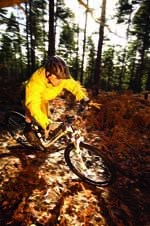 FRAME
FRAME
By moving the seatstay pivot down so that it is now concentric with the rear axle, the disc brake mount is moved onto the seatstay rather than the chainstay.
Trek is calling this the ABP (Active Braking Pivot) and in theory it allows the suspension to move more freely when the rear brake is applied. And while longer travel bikes will be the true beneficiaries of this, the advantages can still be felt out on the trail on the 120mm travel Fuel EX platform. An additional benefit of the concentric pivot is that it allows Trek to build a stiffer rear end. Combine this with the one-piece Evo rocker link and Trek now has a super solid chassis — something we could never have said about its shorter travel US manufactured bikes.
The rocker link’s main pivot does, however, bisect the seat tube so you can’t slam the saddle all the way down. Not a big deal really, as the range of adjustment is more than adequate for a trail bike.
SUSPENSION
OK, so ABP is easy to understand, has a catchy acronym and is clearly visible (as it is 37mm wider than normal), but what is more important to suspension performance on the EX9 is how the shock is worked by the links. This determines how the suspension reacts to bump forces, and by having the upper link chasing the lower link Trek can fine-tune how the suspension characteristics change over the 120mm travel range.
In simple terms, the lower shock mount moves away from the main pivot as the suspension compresses, making the linkage less progressive to compensate for the ramp up of the air spring. This allows for full travel without the suspension being too soft in the initial part of the stroke.
Up front the EX9 gets a custom Fox Talas RLC with 90-110-130mm travel settings. We never ran the fork in anything but the max travel setting, and it does beg the question: why didn’t Trek match travel front and back?
COMPONENTS
Trek uses a mix and match drivetrain — Shimano cranks and front mech, combined with SRAM shifters and rear mech. It’s about as good as it gets when it comes to shifting under power. Avid’s Juicy Carbons with 185mm rotors front and rear are powerful enough for most DH bikes and, seeing as the Bontrager Jones XR tyres are the limiting factor in the braking equation, we’d have gladly settled for a lighter 160mm set-up front and back. Also, before leaving the shop, get the sales assistant to throw in a set of lock-on grips as the Bontrager ones fitted as standard are dreadful.
PERFORMANCE
Before testing the EX9, we were convinced that the longer frame size would feel better — it doesn’t. The position is overly stretched and even when we chipped the stem back from 100mm to 80mm the balance of the bike and the steering characteristics didn’t feel as good as the 17.5in EX9.5 we tested a couple of months back. The extra length just seems to upset the weight distribution and balance of the bike.
Even though the ABP rear end is much wider than normal, there is plenty of stay clearance and we never clipped our heels. Careful positioning of the QR lever is necessary, though, to stop it stabbing you in the leg when you get off to push.
Much to our surprise, the effect of the ABP is noticeable when you’re scrubbing off speed on rocks or bumps, even with the EX9’s limited travel. But more importantly, the R1i tuned suspension is very plush and has good progression, with very little pedal induced bob while seated. Stand up, however, and the Trek lacks the taut suspension feel of the Marin or the Cannondale.
VERDICT
Two major changes have occurred at Trek: manufacturing has been shipped to Taiwan and the Fuel EX9 is all the better for it. Secondly, suspension performance has been improved with the combined effect of ABP and the Full Floater shock mount. All you need to do is get the right size bike to take advantage of it. If you’re of average height we’d recommend the 17.5in Fuel EX9 as it offers sharper handling and is better balanced than the larger size.
MBR RATING: 8/10



